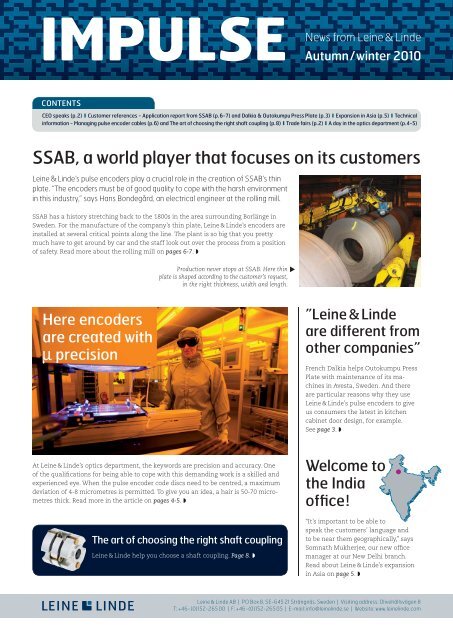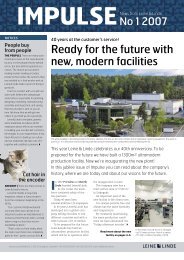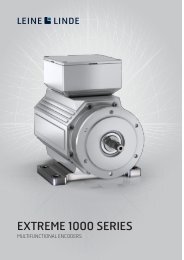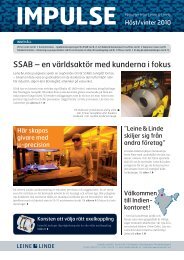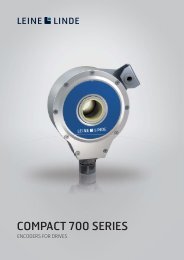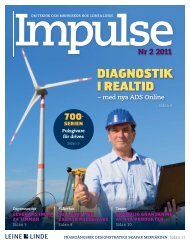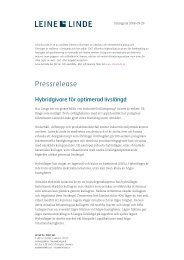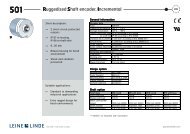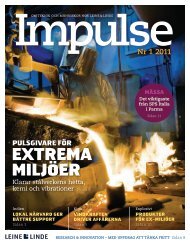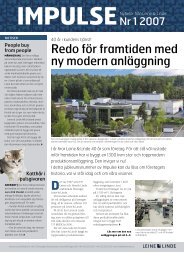Impulse no. 1 – 2010 (PDF) - Leine & Linde
Impulse no. 1 – 2010 (PDF) - Leine & Linde
Impulse no. 1 – 2010 (PDF) - Leine & Linde
Create successful ePaper yourself
Turn your PDF publications into a flip-book with our unique Google optimized e-Paper software.
IMPULSE<br />
News<br />
from <strong>Leine</strong> & <strong>Linde</strong><br />
Autumn / winter <strong>2010</strong><br />
CONTENTS<br />
CEO speaks (p. 2) I Customer references - Application report from SSAB (p. 6-7) and Dalkia & Outokumpu Press Plate (p. 3) I Expansion in Asia (p. 5) I Technical<br />
information - Managing pulse encoder cables (p. 6) and The art of choosing the right shaft coupling (p. 8) I Trade fairs (p. 2) I A day in the optics department (p. 4-5)<br />
SSAB, a world player that focuses on its customers<br />
<strong>Leine</strong> & <strong>Linde</strong>’s pulse encoders play a crucial role in the creation of SSAB’s thin<br />
plate. “The encoders must be of good quality to cope with the harsh environment<br />
in this industry,” says Hans Bondegård, an electrical engineer at the rolling mill.<br />
SSAB has a history stretching back to the 1800s in the area surrounding Borlänge in<br />
Sweden. For the manufacture of the company’s thin plate, <strong>Leine</strong> & <strong>Linde</strong>’s encoders are<br />
installed at several critical points along the line. The plant is so big that you pretty<br />
much have to get around by car and the staff look out over the process from a position<br />
of safety. Read more about the rolling mill on pages 6-7. <br />
Production never stops at SSAB. Here thin<br />
plate is shaped according to the customer’s request,<br />
in the right thickness, width and length.<br />
<br />
Here encoders<br />
are created with<br />
μ precision<br />
”<strong>Leine</strong> & <strong>Linde</strong><br />
are different from<br />
other companies”<br />
French Dalkia helps Outokumpu Press<br />
Plate with maintenance of its machines<br />
in Avesta, Sweden. And there<br />
are particular reasons why they use<br />
<strong>Leine</strong> & <strong>Linde</strong>’s pulse encoders to give<br />
us consumers the latest in kitchen<br />
cabinet door design, for example.<br />
See page 3. <br />
At <strong>Leine</strong> & <strong>Linde</strong>’s optics department, the keywords are precision and accuracy. One<br />
of the qualifications for being able to cope with this demanding work is a skilled and<br />
experienced eye. When the pulse encoder code discs need to be centred, a maximum<br />
deviation of 4-8 micrometres is permitted. To give you an idea, a hair is 50-70 micrometres<br />
thick. Read more in the article on pages 4-5. <br />
The art of choosing the right shaft coupling<br />
<strong>Leine</strong> & <strong>Linde</strong> help you choose a shaft coupling. Page 8. <br />
Welcome to<br />
the India<br />
office !<br />
“It’s important to be able to<br />
speak the customers’ language and<br />
to be near them geographically,” says<br />
Somnath Mukherjee, our new office<br />
manager at our New Delhi branch.<br />
Read about <strong>Leine</strong> & <strong>Linde</strong>’s expansion<br />
in Asia on page 5. <br />
<strong>Leine</strong> & <strong>Linde</strong> AB | PO Box 8, SE-645 21 Strängnäs, Sweden | Visiting address: Olivehällsvägen 8<br />
T: +46-(0)152-265 00 | F: +46-(0)152-265 05 | E-mail: info@leinelinde.se | Website: www.leinelinde.com
CEO SPEAKS<br />
Asia makes <strong>2010</strong> a record year<br />
2009 was a testing year for most<br />
companies. Fortunately we managed<br />
pretty well.<br />
The exceptional growth we had seen in<br />
previous years was <strong>no</strong>t followed by an<br />
increase in tur<strong>no</strong>ver. In spite of that we<br />
are incredibly pleased with how well we<br />
managed during the global financial crisis.<br />
We look back on the year as a breathing<br />
space for all our employees, whom we<br />
have also managed to retain.<br />
The fact that <strong>2010</strong> looks like being a record<br />
year for <strong>Leine</strong> & <strong>Linde</strong> is therefore<br />
a source of great pleasure. One factor<br />
that strongly contributes to this year’s<br />
growth is our continued efforts in Asia. An<br />
establishment that started many years<br />
ago and came at precisely the right time,<br />
with improving market conditions and new<br />
business opportunities opening up. These<br />
efforts will naturally continue, and we<br />
We constantly adapt<br />
to the requirements<br />
and wishes of our<br />
customers<br />
already expect to make further appointments<br />
in Asia.<br />
On the product side, we are continuing to<br />
adapt to the requirements and requests<br />
made by both the authorities and our<br />
customers.<br />
We also look forward to meeting many of<br />
you at our fairs in <strong>2010</strong> / 2011. If you are<br />
unable to visit us at any of the 20 fairs we<br />
have planned, you are always welcome to<br />
visit our website, www.leinelinde.com, to<br />
read our product news.<br />
You are <strong>no</strong>w holding the latest edition of<br />
our customer newsletter IMPULSE. I hope<br />
you will find it interesting and well worth<br />
reading. Until we meet again, I would like to<br />
wish you, our customers, all the best, and<br />
hope your autumn is filled with interesting<br />
new challenges. <br />
Björn Zetterlund<br />
CEO<br />
Autumn fairs s!<br />
Feel free to visit <strong>Leine</strong> & <strong>Linde</strong> at the<br />
following fairs during autumn <strong>2010</strong>. 0.<br />
Sweden<br />
6-7 October EuroExpo, Malmö<br />
China<br />
15-17 September China Paper Shanghai, ai,<br />
Shanghai<br />
<strong>Leine</strong> & <strong>Linde</strong> will be represented at a number of other<br />
fairs via our distributors. Please visit our website,<br />
www.leinelinde.com, for further information.<br />
Fairs as a meeting place are an important part of<br />
<strong>Leine</strong> & <strong>Linde</strong>’s communication work, and we look<br />
forward to seeing you at one of them. <br />
India<br />
21-24 September Automation <strong>2010</strong>,<br />
Mumbai<br />
Germany<br />
21-25 September Husum Wind, Husum<br />
23-25 November SPS, Nürnberg<br />
Finland<br />
5-7 October Teknikka, Jyväskylä<br />
Spain<br />
26-29 October Matelec, Madrid<br />
2
Uninterrupted production at<br />
Outokumpu Press Plate<br />
”Since we started using <strong>Leine</strong> & <strong>Linde</strong>’s products, we’ve had<br />
<strong>no</strong> interruptions to production. Unlike other companies,<br />
deliveries are very fast and the service is faultless.” So says<br />
Roland Åhlund, an engineer at Dalkia in Avesta, Sweden.<br />
Dalkia Dalkia deals with<br />
maintenance of machines<br />
at Outokumpu<br />
Press Plate’s plant in<br />
Avesta. Oskar Orre, who<br />
works as production<br />
manager for Outokumpu<br />
Press Plate, joins us as<br />
our tour guide.<br />
Outokumpu Press<br />
Plate is a subsidiary of<br />
Outokumpu Stainless,<br />
which has been processing<br />
stainless steel for<br />
press plates for 70 years.<br />
Press plates are used for pressing patterns<br />
into laminate flooring and kitchen<br />
cabinet doors. Oskar explains that Outokumpu<br />
Press Plate makes the semi-finished<br />
goods needed, which are then sold<br />
on to their customers.<br />
The company also manufactures<br />
stainless steel kitchen work surfaces<br />
and cisterns that must maintain a high<br />
hygienic standard. A relatively new niche<br />
market is pattern ground plate for decorative<br />
purposes, for decorating building<br />
façades, for example. These plates are<br />
ground in<br />
various patterns,<br />
producing<br />
a 3D<br />
effect.<br />
Oskar explains<br />
how important it is to achieve the correct<br />
hardness and flatness. This is what builds<br />
up the company’s brand.<br />
”The tiniest defect can ruin a whole<br />
plate. The plate is first stretched to remove<br />
all tension, then it is blasted to<br />
remove oxides and to achieve as clean a<br />
surface as possible. When everything is<br />
FACTS<br />
<br />
<br />
<br />
ready, the plate is heated up and cooled<br />
down until it reaches its re<strong>no</strong>wned hardness.<br />
If requested by the customer, the<br />
plate is ground for its intended purpose.”<br />
”The customer’s needs are always<br />
paramount! Both the material and the<br />
work performed are expensive, so any<br />
slipshod work could have devastating<br />
consequences,” Oskar continues.<br />
In order to be able to manufacture this<br />
high-quality plate, the machines must be<br />
working properly.<br />
Roland Åhlund is very pleased with<br />
<strong>Leine</strong> & <strong>Linde</strong>’s products. One gantry<br />
crane is fitted with a multiturn absolute<br />
encoder with a draw-wire unit and<br />
PROFIBUS interface. This encoder indicates<br />
the position of the plate. There is<br />
also an absolute encoder installed in the<br />
blasting machine on the same production<br />
line. This too indicates the exact position<br />
of the plate.<br />
”The quality of <strong>Leine</strong> & <strong>Linde</strong>’s encoders<br />
is very high,” explains Roland, adding<br />
that he is looking forward to continued<br />
cooperation. <br />
Dalkia<br />
Dalkia is a leading European company providing energy and technical services for<br />
companies and the public sector. Dalkia in Avesta focuses on maintenance of machines<br />
in the steel industry. The parent company is located in France, and the group has around<br />
53,000 employees in 41 countries.<br />
Outokumpu Press Plate<br />
Outokumpu Press Plate is a subsidiary of Outokumpu Stainless. It processes stainless<br />
steel. Today the company has 28 employees and is a leader in its field.<br />
<br />
<br />
On site are PROFIBUS encoders from <strong>Leine</strong> &<br />
<strong>Linde</strong> that control the position of the plate.<br />
Inside the production plant at Avesta are<br />
Oskar Orre (Outokumpu Press Plate),<br />
Roland Åhlund (Dalkia) and Håkan Karlsson<br />
(<strong>Leine</strong> & <strong>Linde</strong>).<br />
NOTICE<br />
24-hour<br />
service in Asia<br />
<strong>Leine</strong> & <strong>Linde</strong>’s Asian customers<br />
can ring for service 24 hours a<br />
day <strong>no</strong>w that the company is<br />
beefing up its service and support<br />
organisation.<br />
<strong>Leine</strong> & <strong>Linde</strong> is establishing a new<br />
organisation for service and support<br />
in Asia. One of the things they<br />
are doing is setting up a telephone<br />
service which customers can ring<br />
24 hours a day. Service engineers<br />
will be on hand to answer questions<br />
relating to pulse encoders.<br />
Field support can also be offered if<br />
required.<br />
”Rapid local help guarantees our<br />
customers maximum availability<br />
and optimum performance for<br />
every pulse encoder application<br />
installed. So it was absolutely natural<br />
to develop the new service<br />
organisation,” says service engineer<br />
Zhu Feng, who is in charge of the<br />
Chinese section of the new support<br />
organisation. <br />
3
Precision and accuracy are keywords<br />
Words such as exposure, pattern and developing make you think of photographers and developing<br />
labs, but they are also used by <strong>Leine</strong> & <strong>Linde</strong>’s optics department. Cleanness, quality and accuracy are<br />
required when critical components for pulse encoders are manufactured with micrometre precision.<br />
For an encoder to work, a code disc and<br />
a reference pattern are needed. Once the<br />
two components have been produced and<br />
installed with micrometre precision in<br />
an encoder, an LED can send a beam of<br />
light through them. Depending on what<br />
the pattern looks like and how fast the<br />
encoder shaft is rotating, light pulses are<br />
created and<br />
then converted<br />
into electrical<br />
pulses. It<br />
is these electrical<br />
pulses<br />
that are used<br />
to measure<br />
the speed or<br />
position of the<br />
pulse encoder.<br />
”On Time is a key concept for this department.<br />
The customer must get their product<br />
when they want it,” explains Resadija<br />
Salju<strong>no</strong>vic at the optics department. In<br />
this article we follow Resadija as she<br />
shows us round the production process<br />
that is central to <strong>Leine</strong> & <strong>Linde</strong>’s pulse<br />
encoders.<br />
<strong>Leine</strong> & <strong>Linde</strong> manufacture on demand<br />
from customers and do <strong>no</strong>t keep stocks<br />
of code discs. This means that planning<br />
is crucial, as all line counts between 1<br />
and 10,000 can be manufactured, even in<br />
small batches.<br />
Once the daily planning is finished, the<br />
work list for the day is printed out, with<br />
information on which variants of code<br />
discs are to be produced. They are made<br />
of either glass or plastic material, using<br />
special exposure equipment developed<br />
in-house. An original pattern is used in<br />
the manufacturing process, and it is the<br />
appearance of the original pattern that is<br />
copied onto the actual code disc.<br />
As the entire work process is extremely<br />
sensitive to dirt particles, all work is<br />
performed in a cleanroom.<br />
After exposure, the code disc undergoes<br />
a development process in order to<br />
develop the pattern copied during the exposure<br />
process. Developing is performed<br />
using an automated machine that lowers<br />
the code discs into various tanks containing<br />
developer and water.<br />
It is important that there are <strong>no</strong> spots<br />
left on the code discs from water or<br />
chemicals. So the machine does <strong>no</strong>t just<br />
develop the code discs; it also washes<br />
and dries them.<br />
”It’s like spots being left on a glass<br />
after it has been washed. There must be<br />
absolutely <strong>no</strong> spots like that on the code<br />
discs, because that could disrupt the<br />
pulse encoder’s function,” Resadija explains.<br />
Once developing is complete, the code<br />
disc has been given its special pattern<br />
and is ready for inspection.<br />
”Here it’s important to be extremely<br />
accurate, as the slightest error in the<br />
pattern can cause errors that lead to the<br />
finished pulse encoder <strong>no</strong>t working properly.<br />
It is partly a visual assessment of<br />
results, which demands skilled and experienced<br />
staff. In addition, all code discs<br />
are checked in an automatic system for<br />
their optic signal quality. Therefore, accuracy<br />
and quality are two keywords for the<br />
optics department,” Resadija says.<br />
After the code disc has been made a<br />
reference pattern is also required so that<br />
the finished pulse encoder will have the<br />
right function. The reference pattern<br />
is developed on a piece of glass that is<br />
glued firmly inside the pulse encoder.<br />
This gluing is performed by a gluing robot,<br />
and once it is finished the reference<br />
pattern is exposed on the piece of glass. It<br />
is extremely important for the reference<br />
pattern to be perfectly straight so that it<br />
can function correctly with the code disc.<br />
The piece of glass with the reference pattern<br />
undergoes the same process as the<br />
code disc, with exposure, developing and<br />
inspection.<br />
”Just as in the code disc work, there<br />
is a visual assessment in the inspection.<br />
A skilled and experienced eye checks<br />
whether there are any errors in the pattern.<br />
No quality without accuracy,” explains<br />
Resadija.<br />
Finally the code disc and reference pattern<br />
are installed in the encoder. Here too<br />
precision is a keyword. The code disc is<br />
centred on the encoder shaft and if this<br />
is <strong>no</strong>t done properly there is an accuracy<br />
error.<br />
Using special equipment, Resadija<br />
centres the code disc in its correct position<br />
on the shaft, extremely precise work.<br />
The maximum permitted deviation from<br />
the <strong>no</strong>minal position is 4-8 micrometres.<br />
By way of comparison, a single hair is<br />
around 50-70 micrometres thick.<br />
When the centring work is finished,<br />
the glue holding the code disc to the<br />
encoder shaft is hardened using UV light,<br />
and the department’s work is done. The<br />
finished robust optic module then moves<br />
to final assembly, where the complete<br />
encoder is assembled. <br />
4
in the optics department<br />
NOTICE<br />
<strong>Leine</strong> & <strong>Linde</strong><br />
establish a<br />
presence in<br />
India & Korea<br />
<br />
<br />
CLEANROOM RULES<br />
The cleanroom guarantees product quality and is necessary for stable manufacturing<br />
processes.<br />
The following rules and requirements apply for a cleanroom of ISO class 6, which<br />
corresponds to <strong>Leine</strong> & <strong>Linde</strong>’s cleanroom:<br />
Particle concentration<br />
Max 35,200 particles ≥ 0,5µm/m 3 air.<br />
Temperature<br />
Always 21°C and a relative humidity of 45 per cent.<br />
Clothing<br />
Always special cleanroom clothing with overalls, cap and special shoes.<br />
Work methods<br />
Follow a specific work method, <strong>no</strong> fast or expansive movements.<br />
Cleaning<br />
All materials must be washed and cleaned before being taken into the cleanroom.<br />
Overpressure<br />
The cleanroom has a constant overpressure. Higher pressure in the cleanroom than<br />
outside prevents dirty air and particles being sucked in.<br />
Earlier this year <strong>Leine</strong> & <strong>Linde</strong><br />
opened two new branches in<br />
New Delhi and Changwon. Now<br />
the company can provide a better<br />
service to local and global<br />
customers operating in southeast<br />
Asia.<br />
There is a huge market for pulse<br />
encoders in Asia and <strong>Leine</strong> & <strong>Linde</strong><br />
are continuing to increase their<br />
market share.<br />
”It’s important to be able to<br />
speak the customers’ language and<br />
to be near them geographically,”<br />
says Somnath Mukherjee, office<br />
manager at <strong>Leine</strong> & <strong>Linde</strong> in New<br />
Delhi.<br />
”<strong>Leine</strong> & <strong>Linde</strong> have had an office<br />
in China for some time, and<br />
the new Changwon and New Delhi<br />
offices are part of a strategy aiming<br />
to provide high levels of availability<br />
and service to all customers,” says<br />
CEO Björn Zetterlund.<br />
”Many of our customers are also<br />
moving elements of their production<br />
and exporting more and more<br />
to India and Korea. So it’s logical<br />
for us to have a permanent presence<br />
in the region.” <br />
<strong>Leine</strong> & <strong>Linde</strong>’s New Delhi office is<br />
opened by Dr. Ewa Björling, Sweden’s<br />
Minister for Trade; Håkan Eriksson,<br />
<strong>Leine</strong> & <strong>Linde</strong>’s Global Key Account<br />
Manager and Somnath Mukherjee,<br />
<strong>Leine</strong> & <strong>Linde</strong> India.<br />
5
TECHNICAL INFORMATION<br />
Handling pulse encoder cables<br />
When a pulse encoder is installed, attention must be paid to the fact that the<br />
connection cables can only tolerate a certain level of stress. The cable specifications<br />
must always match the requirements of the application. Cheap cables<br />
often reduce system function and are seldom a good investment in the long run.<br />
If cables are pulled, coiled, bent or subjected<br />
to pressure they can be damaged.<br />
Cables subjected to this kind of impact<br />
should always be replaced.<br />
<strong>Leine</strong> & <strong>Linde</strong> recommends that connection<br />
cables for pulse encoders always<br />
be laid in a separate cable duct. In combination<br />
with other measures, this improves<br />
the EMC properties for the entire<br />
installation. If there is only one combined<br />
cable duct available for signal and power<br />
cables, the signal cables should be bundled<br />
together and positioned as far away<br />
as possible from power cables. There are<br />
several advantages to separation:<br />
Better EMC properties<br />
Better protection from damage, for<br />
example if bigger power cables are laid<br />
in the same duct at a later point<br />
Simpler fault tracing during maintenance.<br />
If despite everything there is disturbance<br />
from surrounding equipment, <strong>Leine</strong> &<br />
<strong>Linde</strong>’s Optolink solution can always be<br />
used. Transmitting pulse encoder signals<br />
via an optical fibre cable eliminates the<br />
risk of disturbance.<br />
Unused cables in multiconductor<br />
Cable conductors should always be<br />
regarded as live, during installation as<br />
well as when the system is operational.<br />
Unused cables must therefore always be<br />
insulated to prevent short circuits.<br />
Mechanical damage to cabling<br />
Pulse encoder cables should always be<br />
laid in an earthed aluminium or steel<br />
pipe when they are placed near to moving<br />
machine parts. When the cable is laid,<br />
particular care must always be taken to<br />
ensure the cable is <strong>no</strong>t subjected to mechanical<br />
impact.<br />
Storage and transport<br />
During storage, transport and installation,<br />
pulse encoder cables should be kept<br />
sealed at both ends or be kept in their<br />
protective packaging. This is to prevent<br />
oxidation of the individual cables, their<br />
shields and protective sheaths. It is also<br />
important to prevent moisture collecting<br />
in the cable.<br />
Surrounding environment<br />
If the pulse encoder’s stated maximum or<br />
minimum temperature is exceeded, this<br />
can damage the electrical or mechanical<br />
properties of the cables. The temperature<br />
readings for installed cables should<br />
always match the temperature readings<br />
for the pulse encoder at the installation<br />
point. In flexible installations, where the<br />
cable moves, the temperature readings<br />
for the cable and the encoder may differ.<br />
In such cases, always contact <strong>Leine</strong> &<br />
<strong>Linde</strong> for more information about your<br />
cable variant.<br />
Elasticity<br />
Cables should <strong>no</strong>t be subjected to more<br />
stretching than they can cope with during<br />
handling and installation.<br />
Pressure on cables<br />
Always avoid pressure on the cable. This<br />
can arise in connection with incorrect<br />
installation.<br />
Twisting / rotation of cable<br />
Twisting or excessive rotation of the cable<br />
can lead to destruction of the wires<br />
or insulation of the cable. Cables should<br />
therefore <strong>no</strong>t be twisted unless they have<br />
been specially designed for that purpose.<br />
Bending radius<br />
The cable’s permitted bending radius<br />
must be maintained. Failing to do this<br />
can lead to damage or to a reduction in<br />
the transmission capabilities of the cable.<br />
Please <strong>no</strong>te that the permitted bending<br />
radius is often higher when the cable<br />
moves in its application than when it is<br />
installed in a fixed position.<br />
Loops<br />
Try to ensure that the cable does <strong>no</strong>t<br />
form loops when it is installed in an application.<br />
This can lead to poorer EMC<br />
resistance and mechanical damage. The<br />
cables must be installed without being<br />
twisted. When you install the cables,<br />
make sure that they can<strong>no</strong>t be subjected<br />
to any unpermitted impact at a later<br />
point once they<br />
are installed. <br />
Dirt, grease, oil and vibrations… An environment<br />
that <strong>Leine</strong> & <strong>Linde</strong>’s encoders<br />
are well able to cope with. The picture<br />
shows the assembled product at one of<br />
SSAB’s plants.<br />
SSAB, a wor<br />
Hans Bondegård, electrical engineer on<br />
the format line, meets us at the gates to<br />
the huge SSAB Borlänge plant in Sweden.<br />
After we have been issued with visitors’<br />
passes and protective clothing we drive<br />
into the area. Here you don’t walk from<br />
door to door; you have to drive around<br />
this e<strong>no</strong>rmous area.<br />
Hans has worked at<br />
SSAB for 32 years,<br />
and during our<br />
visit it becomes<br />
clear that he is<br />
extremely k<strong>no</strong>wledgeable<br />
about<br />
his field.<br />
Hans shows us the<br />
way in to the production line belonging to<br />
the format line production section.<br />
”Here thin plate is shaped according<br />
to the customer’s request with regard to<br />
thickness, width and length. The thinnest<br />
plate is just 3 mm thick and the thickest<br />
is around 16 mm. The raw material is<br />
supplied in large coils in pre-determined<br />
thicknesses, direct from SSAB’s rolling<br />
mill,” explains Hans.<br />
The format line produces around<br />
350,000 tons a year and the staff work in<br />
five shifts. Production never stops. The<br />
whole process operates as a single line<br />
and the department is therefore called<br />
simply the format line. There’s hardly<br />
anyone along the production line. Hans<br />
laughs and points to a cabin. The staff sit<br />
in there, controlling the whole work process<br />
via monitors and control systems,<br />
which explains the lack of people in the<br />
area.<br />
6
<strong>Impulse</strong> visited steel manufacturer SSAB in Borlänge to see how <strong>Leine</strong> & <strong>Linde</strong>’s encoders function in the<br />
harsh environment they are made for. The encoders play a crucial part in the production of SSAB’s thin plate.<br />
Jessica Zetterberg from <strong>Leine</strong> & <strong>Linde</strong> visits<br />
SSAB. Here she is seen in front of the coils.<br />
<strong>–</strong><br />
ld player that focuses on its customers<br />
The start of the line is where the actual<br />
coils are centred. The positioning of the<br />
coil is important, as it must be centred in<br />
the straightener. Along the line are several<br />
encoders, both absolute and incremental.<br />
Hans says that he is just about to<br />
install a multiturn absolute encoder with<br />
a draw-wire unit from <strong>Leine</strong> & <strong>Linde</strong>. This<br />
encoder will provide information on the<br />
position of the large coil. Hans has great<br />
hopes for the new encoder, as previous<br />
measurement methods have <strong>no</strong>t been<br />
satisfactory.<br />
In the double straighteners the plate is<br />
bent and stretched to remove all tension<br />
in the material. The straighteners also<br />
have <strong>Leine</strong> & <strong>Linde</strong> pulse encoders, used<br />
to reset the gap to suit the thickness of<br />
the raw material.<br />
Once the tension is gone, the plate can<br />
be trimmed and cut to the correct length.<br />
The cutting is done using dividing shears.<br />
Here there is an absolute encoder making<br />
sure the material is cut to the right<br />
length.<br />
Three samples are taken from each coil,<br />
one from the start, one from the middle<br />
and one from the end.<br />
”Quality is absolutely crucial for SSAB<br />
and our customers are always at the<br />
centre of what we do. Poor quality means<br />
<strong>no</strong> customers,” Hans explains.<br />
Once cut correctly, the plate must be<br />
straightened once again to remove any<br />
remaining tension. As soon as the final<br />
straightening is complete, the plate is<br />
labelled to make it traceable <strong>–</strong> quality is<br />
considered here too.<br />
We are <strong>no</strong>w approaching the end of<br />
line. This entire process takes about 15<br />
minutes per coil. All that is left is stacking<br />
of plates by weight and height according<br />
to the customer’s request, and,<br />
of course, packaging. The machine that<br />
stacks the plates has several <strong>Leine</strong> &<br />
<strong>Linde</strong> encoders installed. The most important<br />
is an absolute encoder that indicates<br />
the positioning of the plates. Then<br />
it’s time to move the plates to the warehouse,<br />
from where they will be picked up<br />
by a transport company for delivery to<br />
the customer.<br />
Why did you choose <strong>Leine</strong> & <strong>Linde</strong> <br />
”They are easy to get hold of and provide<br />
a good service. And the new website really<br />
deserves praise. The encoders have<br />
to be durable if they are going to cope<br />
with the harsh environment in this<br />
industry,and I’m a satisfied <strong>Leine</strong> & <strong>Linde</strong><br />
customer,” concludes Hans. <br />
Roots in the 1800s<br />
Today’s Swedish steel industry started<br />
to take off at the end of the nineteenth<br />
century. At that time small-scale steel<br />
mills were being replaced by larger<br />
steelworks to cater for growing international<br />
competition. In 1872 it was<br />
decided that a new steelworks should be<br />
built in Borlänge by the Domnarv rapids,<br />
Domnarvets Jernverk. The decision was<br />
taken after the railway line was built<br />
between Falun and Göteborg. Borlänge<br />
provided the ideal location. By the<br />
middle of the twentieth century, Domnarvets<br />
Jernverk had grown into a large<br />
company. Thanks to modernisations<br />
and rationalisations, at the beginning<br />
of the 1970s Domnarvets Jernverk had<br />
as many as 6,300 employees. In the<br />
mid-70s the steel industry had to undergo<br />
restructuring once more due to<br />
the energy crisis. The result was that the<br />
steelworks at Norrbotten, Domnarvet<br />
and Oxelösund merged following a Riksdag<br />
resolution in 1977. SSAB <strong>–</strong> Svenskt<br />
stål AB <strong>–</strong> was formed. Today SSAB is a<br />
world-leading supplier of high-tensile<br />
steel with customers and companies<br />
all over the world. The group’s sales<br />
amounted to SEK 29.8 billion in 2009<br />
and it has been listed on the Stockholm<br />
stock exchange since 1989.<br />
7
IMPULSE Autumn / Winter <strong>2010</strong><br />
TECHNICAL INFORMATION<br />
The art of choosing the right shaft coupling<br />
To put it in simple terms, the purpose of a shaft coupling is to transfer rotational force from one shaft to a<strong>no</strong>ther. To do this effectively,<br />
the coupling must have a high torsional rigidity. Factors that should be taken into account when a shaft coupling is to<br />
be specified are: torsional rigidity, backlash, torque, environmental factors that affect the shaft coupling and its mounting system.<br />
Common to all installations of pulse<br />
encoders with a solid shaft end is that<br />
a good quality shaft coupling should be<br />
chosen. This ensures a good service life<br />
and measurement accuracy.<br />
Choosing the right shaft coupling<br />
The following guidelines will help you<br />
choose the right shaft coupling:<br />
The coupling must be able to tolerate<br />
the displacements that can occur between<br />
the shafts<br />
The coupling must be able to transfer<br />
the required torque<br />
The coupling must be able to cope<br />
with the required rotation speed<br />
The coupling must comply with environmental<br />
and space requirements on<br />
site.<br />
Installation and handling<br />
Like a pulse encoder, a shaft coupling<br />
is a component that must be handled<br />
carefully by trained staff. <strong>Leine</strong> & <strong>Linde</strong><br />
recommends that you always replace<br />
the shaft coupling whenever a new pulse<br />
encoder is installed.<br />
The following guidelines will take you<br />
through a correct installation that will<br />
give the coupling the maximum service<br />
life:<br />
Make sure that the shafts are smooth<br />
and undamaged, and that they can<br />
penetrate the bore of the shaft coupling<br />
Install the coupling by holding the<br />
encoder while at the same time rotating<br />
the coupling back and forth as you<br />
pass it along the shaft<br />
Do <strong>no</strong>t use any more force than the<br />
coupling can cope with when it is extended<br />
or pushed together. <br />
Properties of different shaft couplings<br />
Nickel<br />
bellows coupling<br />
High-performance<br />
precision coupling<br />
with excellent kinematic<br />
properties.<br />
First-class applications<br />
with strict<br />
requirements for<br />
measurement accuracy.<br />
Membrane<br />
coupling<br />
Precision coupling<br />
with excellent kinematic<br />
properties.<br />
Dynamically balanced<br />
construction.<br />
High-speed applications<br />
where exactness<br />
is required.<br />
Harsh environments<br />
with independent<br />
drive shafts.<br />
Description<br />
Areas of application<br />
Speeds<br />
Sliding disc<br />
coupling (Oldham type)<br />
Multi-purpose<br />
coupling. Robust,<br />
user-friendly threepart<br />
coupling with<br />
replaceable components.<br />
Easy to fit.<br />
Applications where<br />
simple installation<br />
and electrical insulation<br />
are required.<br />
Double loop<br />
coupling<br />
Exceptional tolerance<br />
for angles<br />
and radial and axial<br />
movements.<br />
Normal applications<br />
with limited<br />
speeds and with low<br />
requirements for<br />
accuracy.<br />
Max 5000 rpm Max 5000 rpm Max 3000 rpm Max 3000 rpm<br />
Max torque for a ø10mm shaft coupling<br />
328 Ncm 5,6 Nm 4 Nm 1,8 Nm<br />
Angle 8º<br />
Radial 0,46 mm<br />
Axial 2,07 mm<br />
Max displacement compensation for a ø10mm shaft coupling<br />
Angle 3º<br />
Radial 0,2 mm<br />
Axial ±0,2 mm<br />
Temperature<br />
Angle 0,5º<br />
Radial 0,2 mm<br />
Axial ±0,1 mm<br />
Angle 15º<br />
Radial 3,2 mm<br />
Axial ±7,5 mm<br />
-40ºC to +120ºC -40ºC to +120ºC -20ºC to +60ºC -40ºC to +100ºC<br />
Electrical insulation<br />
No No Yes Yes<br />
Clamping or set<br />
screw<br />
Type of fitting for encoder shaft<br />
Clamping or set<br />
screw<br />
Clamping or set<br />
screw<br />
Set screw<br />
<strong>Leine</strong> & <strong>Linde</strong> AB | PO Box 8, SE-645 21 Strängnäs, Sweden | Visiting address: Olivehällsvägen 8<br />
T: +46-(0)152-265 00 | F: +46-(0)152-265 05 | E-mail: info@leinelinde.se | Website: www.leinelinde.com


